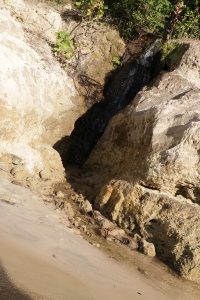This week’s musical guest on Local Routes is Taller Trees, who perform their song Old As Earth. That’s kind of the theme of this video as well. In it, we look at rocks and fossils with geologist Harley Means. He shows us what the old earth around the Apalachicola River tells us about its ancient past.
Music in this video was provided by Chris Matechik. You can catch his band, The Flatheads, playing in and around Apalachicola. The RiverTrek kayak trip featured in this story is a fundraiser for Apalachicola Riverkeeper.
Subscribe to receive more videos and articles about the natural wonders of our area.
Rob Diaz de Villegas WFSU Media
Alum Bluff was once Apalachicola Bay. Currently, it towers above the Apalachicola River, 84 miles from the coast. Florida’s largest geologic outcropping is a peek under the skin of the earth, eroded into view by the river. Here, we can see millions of years of shifting shorelines and animals long gone. And by we, I mean geologist Harley Means. He sees these things, and he was nice enough to interpret them for us on RiverTrek 2016.
When I first kayaked the river on RiverTrek 2012, I was surprised at the terrain we saw on our first day. A hike on Means Creek took us into a mini canyon, and then a cave. We ended the day at Alum Bluff, which we climbed the next morning. It didn’t feel like Florida.
Just before this last RiverTrek, I saw there would be a geologist along for that rocky day one. I had to go along. I had to know more about what is known as the Apalachicola Bluffs and Ravines area of the river.
An added bonus is that the geologist in question grew up exploring the ravines along the Apalachicola. Harley’s father is Dr. Bruce Means. Since Harley was a child, Dr. Means has searched steephead ravines for snakes and salamanders. Often, Harley was there with Bruce’s students, receiving an early education.
“That was sort of my first experience in looking at how unique this area is,” Harley remembers. After about an hour on the water, the kayakers pulled up to an off-trail section of Torreya State Park. There, Harley led us into a creek named for his father.
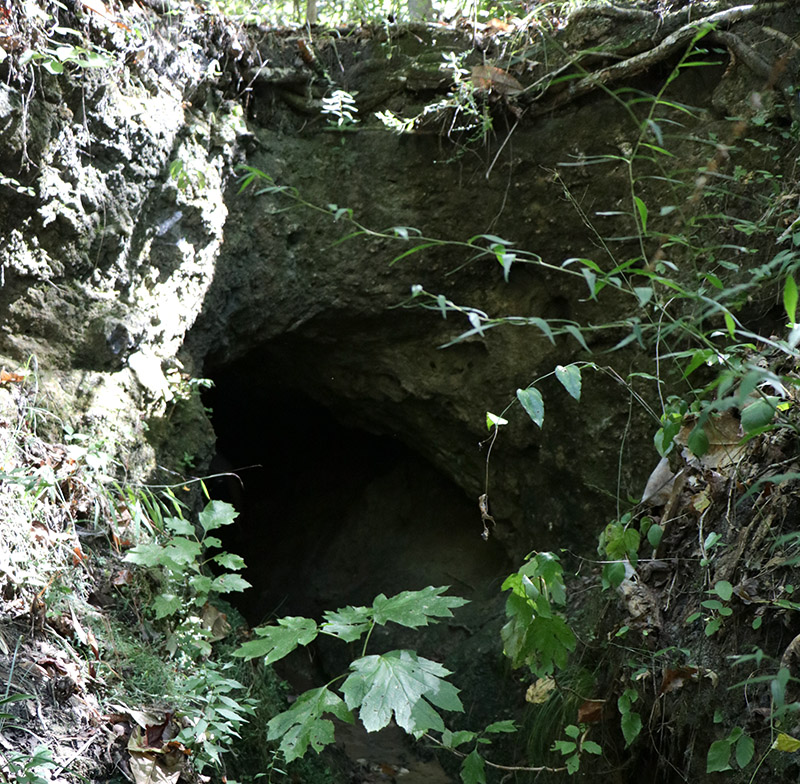
A geologist’s perspective on Means Creek
A few minutes after climbing down into Means Creek, the Means leading our trip found an Apalachicola dusky salamander. Not to be outdone, Tall Timbers’ biologist Kim Sash found a banded water snake. Harley grew up at Tall Timbers Research Station during Bruce’s tenure there. Bruce Means served as its director for almost a decade before leaving to found the Coastal Plains Institute.
After finding the kinds of critters associated with his father, Harley found something more in line with his own scientific focus. A few brown bones stuck out of the limestone wall, a species of dugong that swam in shallow coastal waters over twenty million years ago.
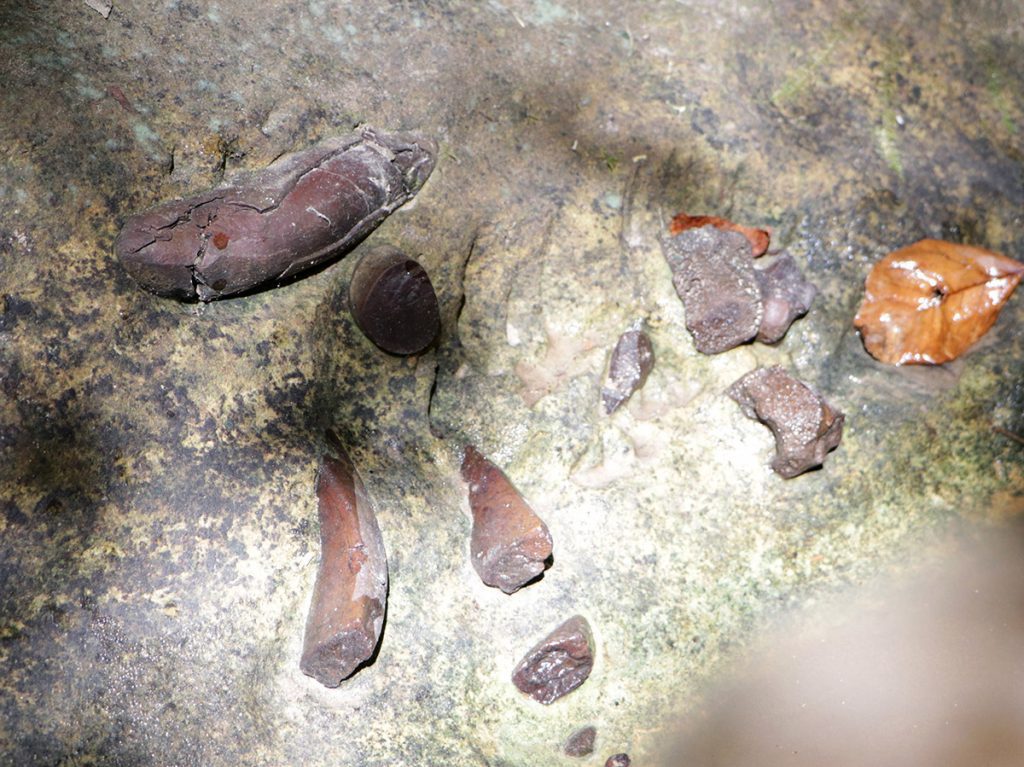
I’ve hiked this creek a few times. It never occurred to me that salamanders were lurking in the mud beneath my feet, or that the rock walls contained ancient fossils. Not only does that show why it’s fun to go into nature, it also shows why it’s rewarding to keep exploring the same place over time. Harley sums it up nicely:
“I would impress upon people, when you’re out and about in nature, be observant. You’re liable to see something each time you go that you didn’t see before. You know, why do I keep going back to Alum Bluff? I’ve been there over a hundred times in my lifetime, and counting. And I’m going to continue to go back, because every time I go there, I see something different, I see something unique. I see something that gives me now a bigger and better picture of the history of the area, and it’s great. All you have to do is get out and look.”
I like this quote because it not only sums up this EcoAdventure, but the spirit of the WFSU Ecology Blog as well.
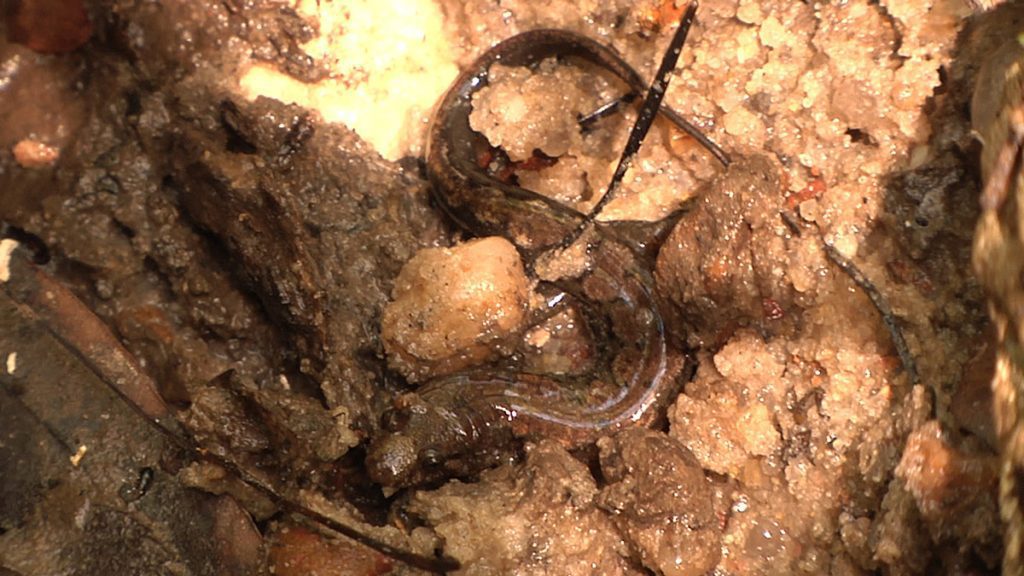
“Why do I keep going back to Alum Bluff?”
On my own return to the Alum Bluff sandbar that day, I noticed something that had previously escaped my attention. There were all manner of wildflowers growing there.
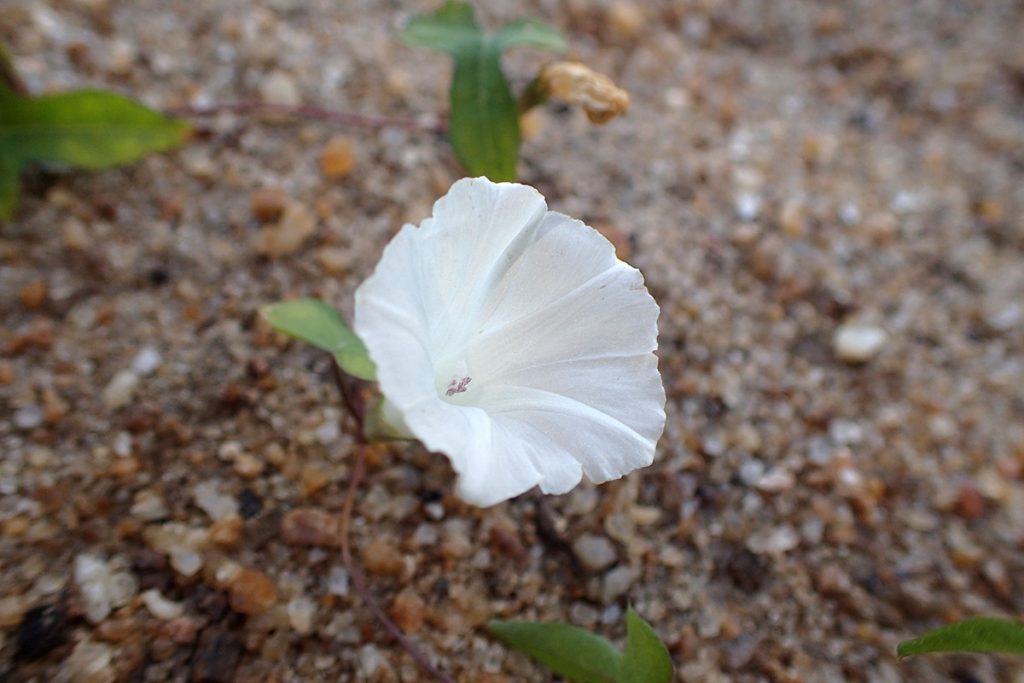
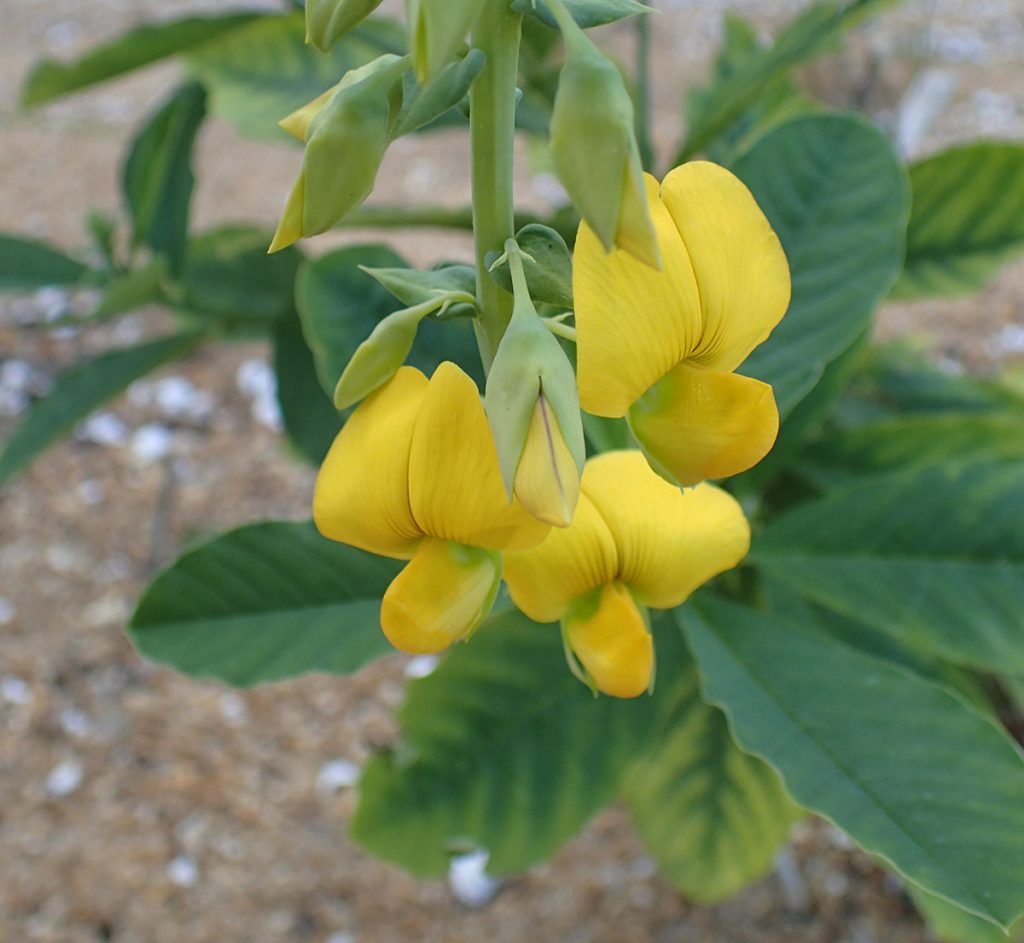
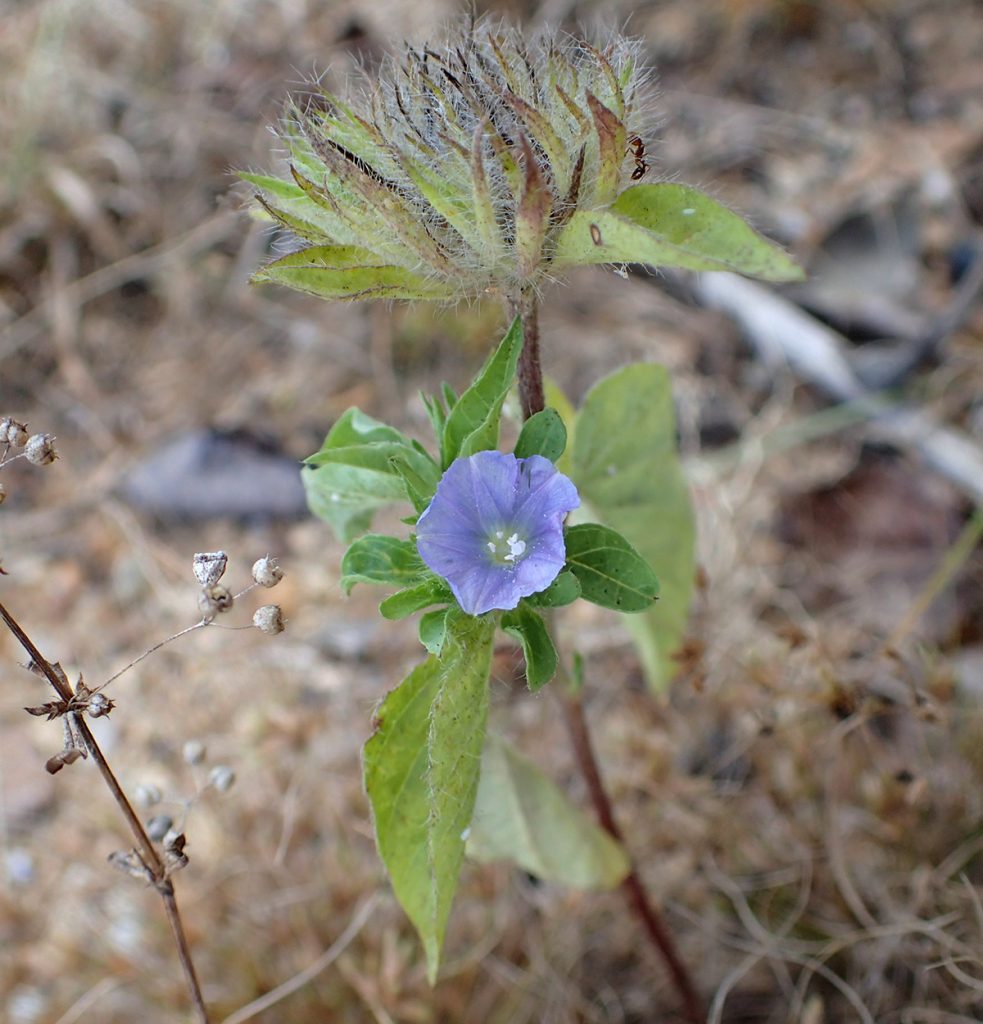
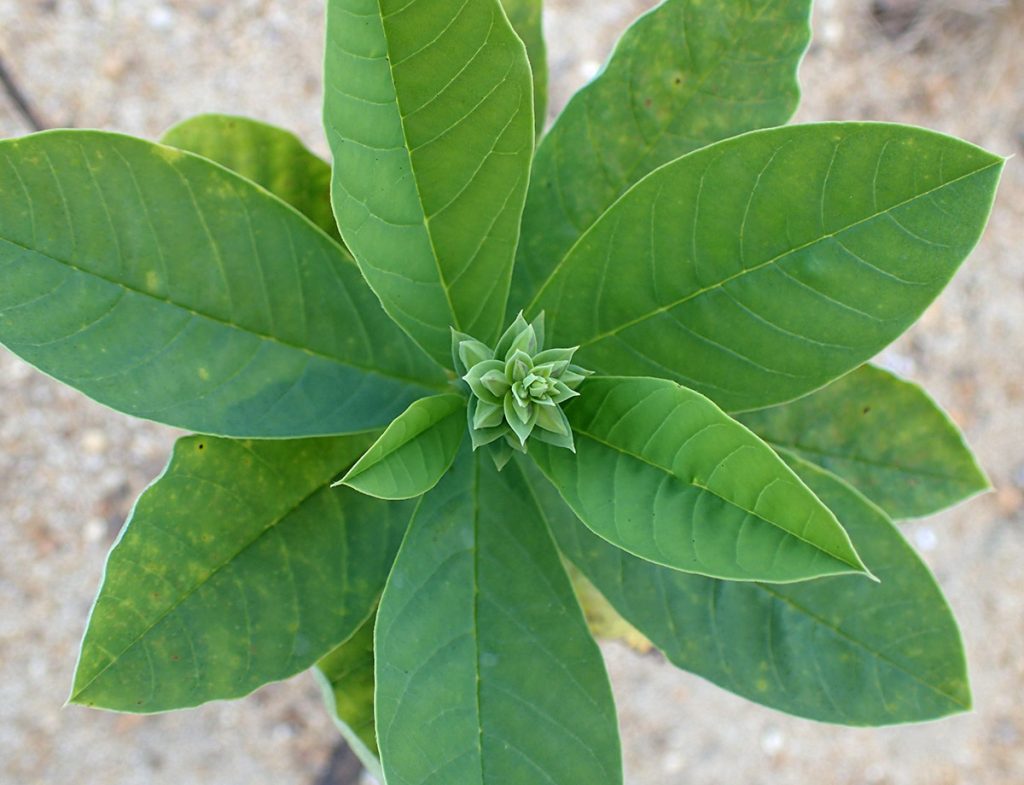
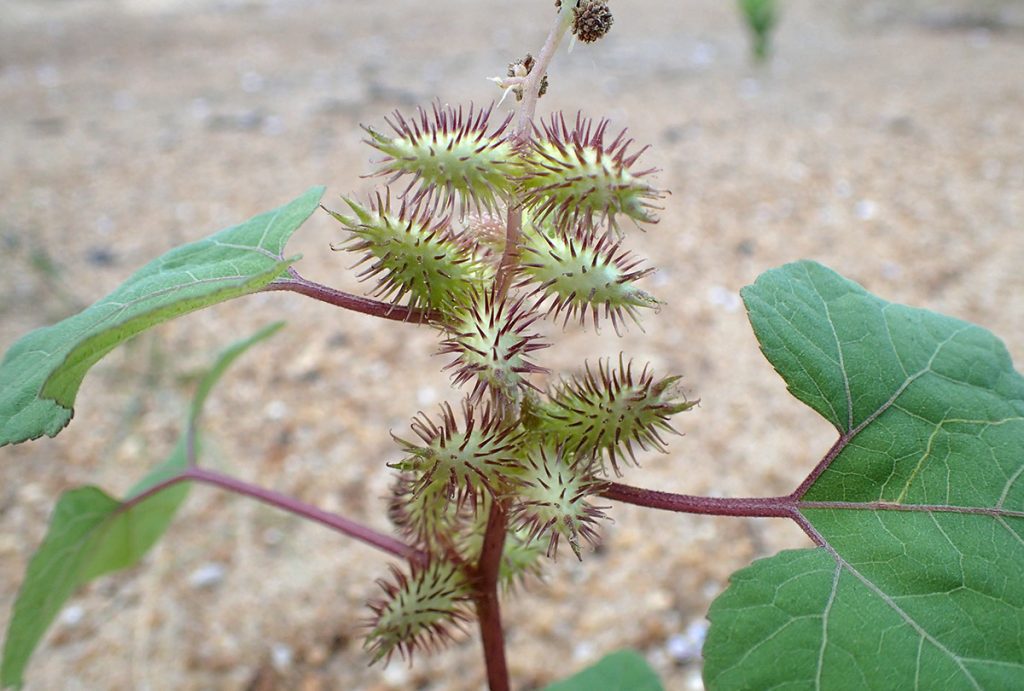
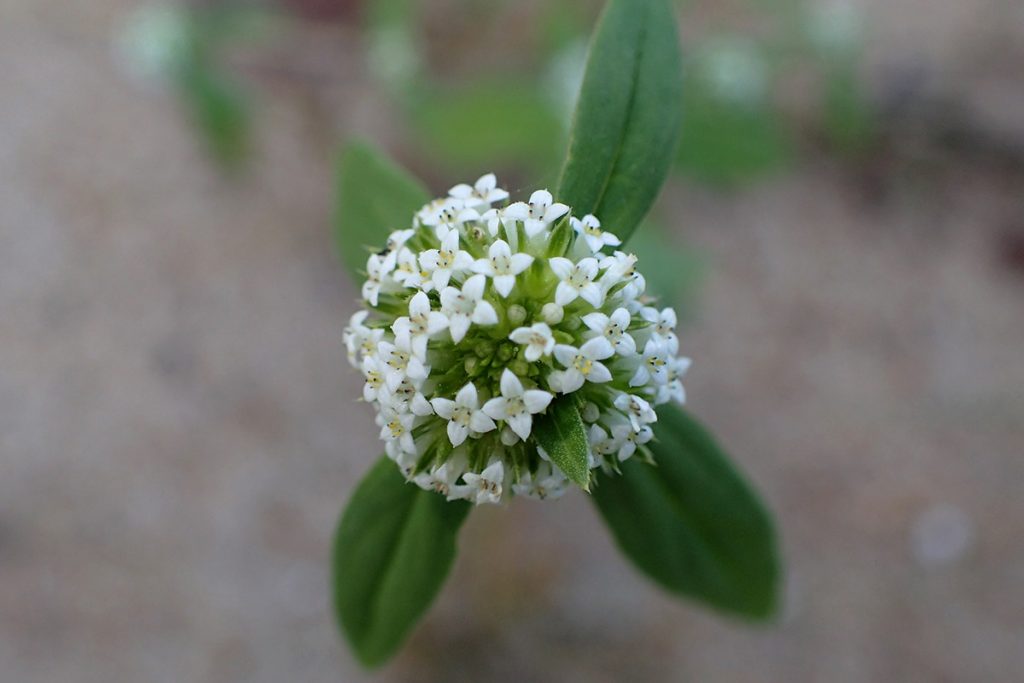
Across the river, the setting sun tinted the face of Alum Bluff. The largest geologic outcropping in Florida looks like heaps of different colored rocks piled on each other. It might take a geologist to fully appreciate its beauty.
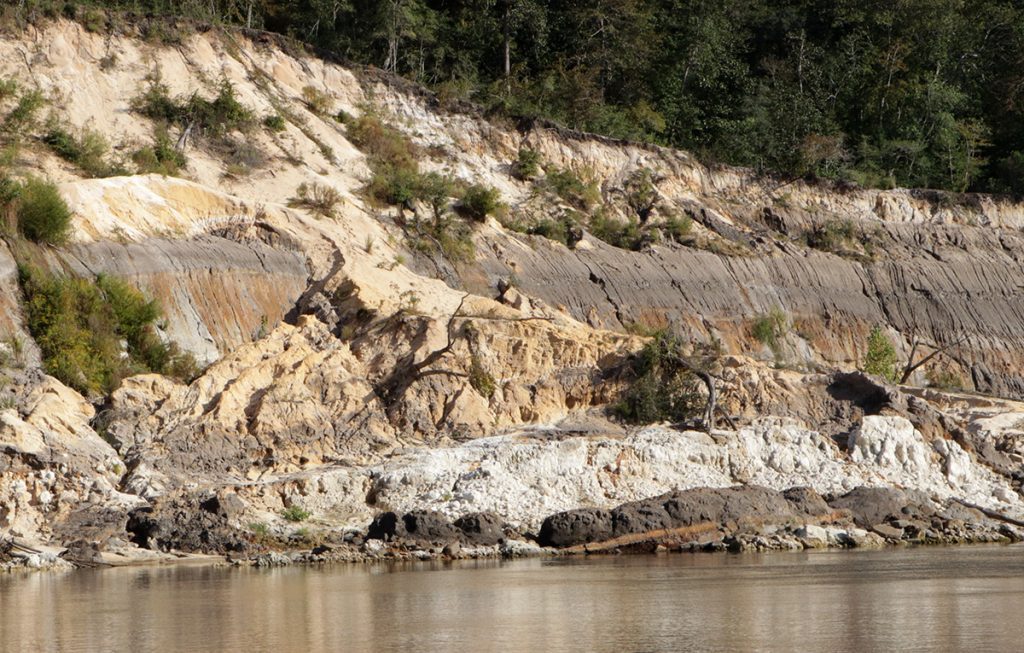
It doesn’t take a geologist, however, to appreciate some of the fossils Harley has found there. As Harley explains in the video, our area had once been under a shallow sea. He knows this from the types of rocks here, and those fossils I just mentioned. The limestone that underlies much of Florida is made from corals and mollusks such as clams and snails.
In the video, we see several photos of the fossils Harley has found at Alum Bluff over the years. Due to the limited time we get for each segment, we didn’t fully explain every fossil we saw. Scroll down for a deeper look at the critters of Apalachicola Bay’s past:
Megafauna | the large marine animals of Alum Bluff
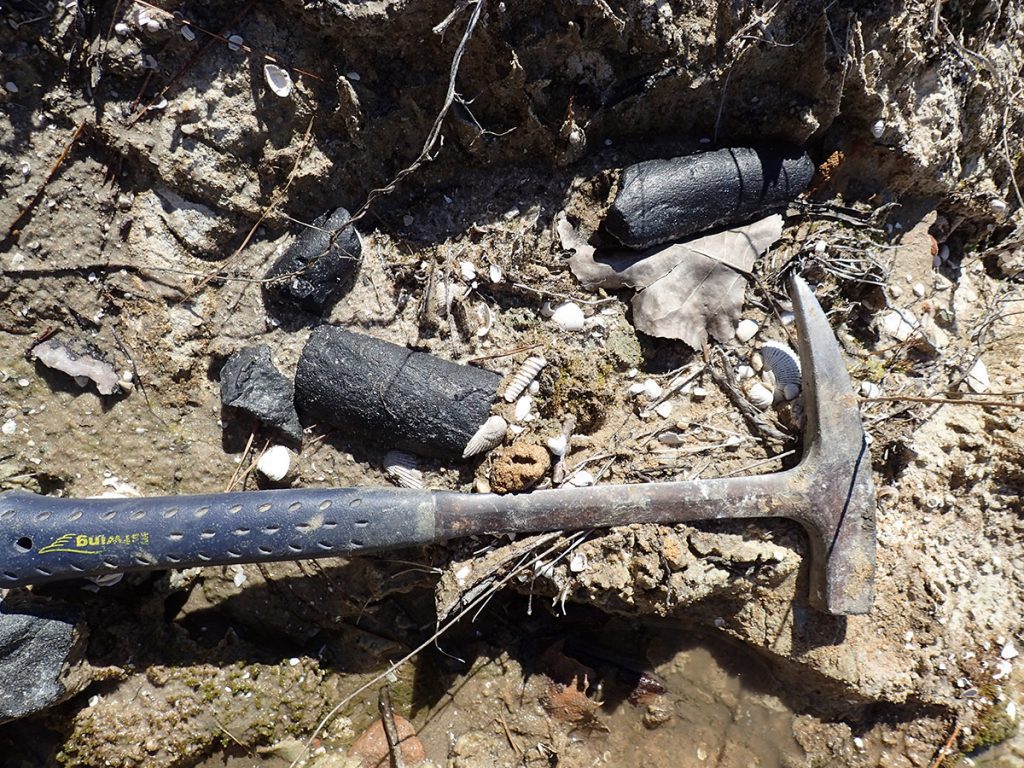
Here are more dugong bones, found in the Jackson Bluff formation, which dates back to three million years ago. The dugong bones in Means Creek were found in the Chattahoochee Formation, which is over 20 million years old.
These rock formations are a key to the age of the fossils found within them. Also, the composition of the rocks tells us something about the environment during these times. Limestone is made of creatures found in the ocean, so we know areas with limestone bedrock were once under water.
And, as Harley pointed out, we have seen fossils of two dugong species separated by 15 million years or so. Comparing the two, paleontologists can get a sense of how that animal evolved in our area.
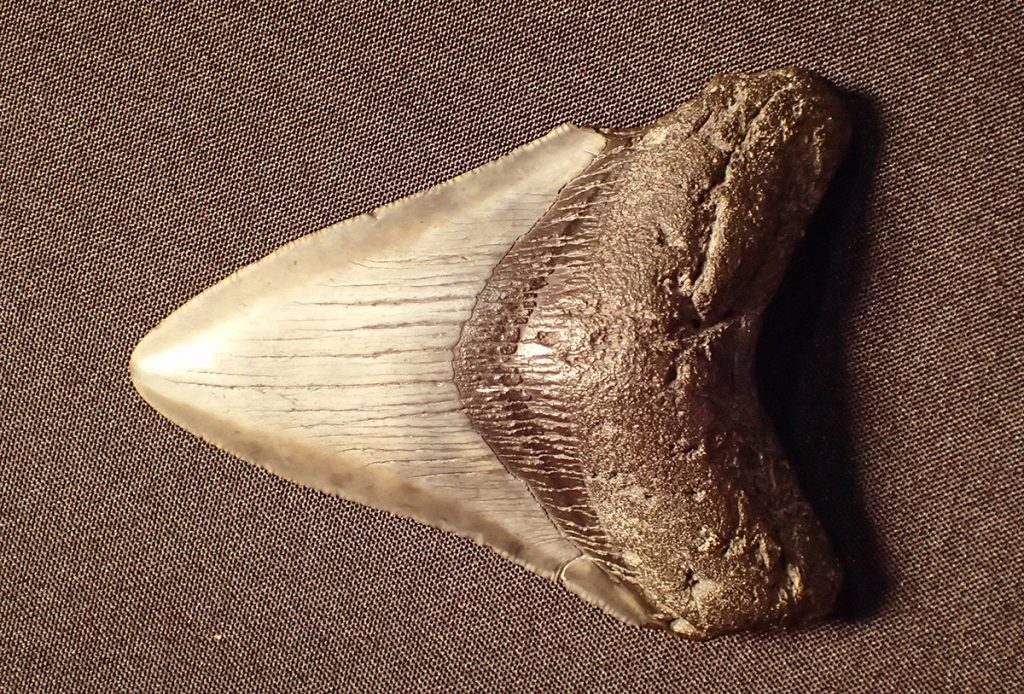
This is a Megalodon tooth, and from what Harley says, they can be much bigger. This shark species went extinct about three million years ago, and much of what we know about it comes from its teeth. Shark skeletons are made of cartilage, so we don’t have big Megalodon fossils.
The teeth look similar enough to great white sharks that scientists believe the two species are related. So, if you compare the size of a great white tooth to its body length, and then calculate how proportionately big a shark would be with Megalodon teeth, you can take a guess that a Megalodon could have been greater than 50 feet in length. It’s not a definitive length, but it’s the best paleontologists can do with the available information.
Other fossils can give us more information about Megalodons in the area. “What would a shark, fifty feet long, be doing in an area that was presumably a shallow marine environment, was probably an estuary?” Harley asked. “What would a fifty-foot-long fish eat?”
Alum Bluff also contains fossilized whale bones. “Oftentimes, those bones will have nice big long scrape marks that look like they might have been tooth marks. So these guys were probably eating whales.”
Millions of Fossil Shells
The estuary that Harley mentions was likely off the mouth of an ancient river, a forerunner to today’s Apalachicola/ Chattahoochee/ Flint basin. Like the modern Apalachicola Bay estuary, it was filled with bivalves and snails.
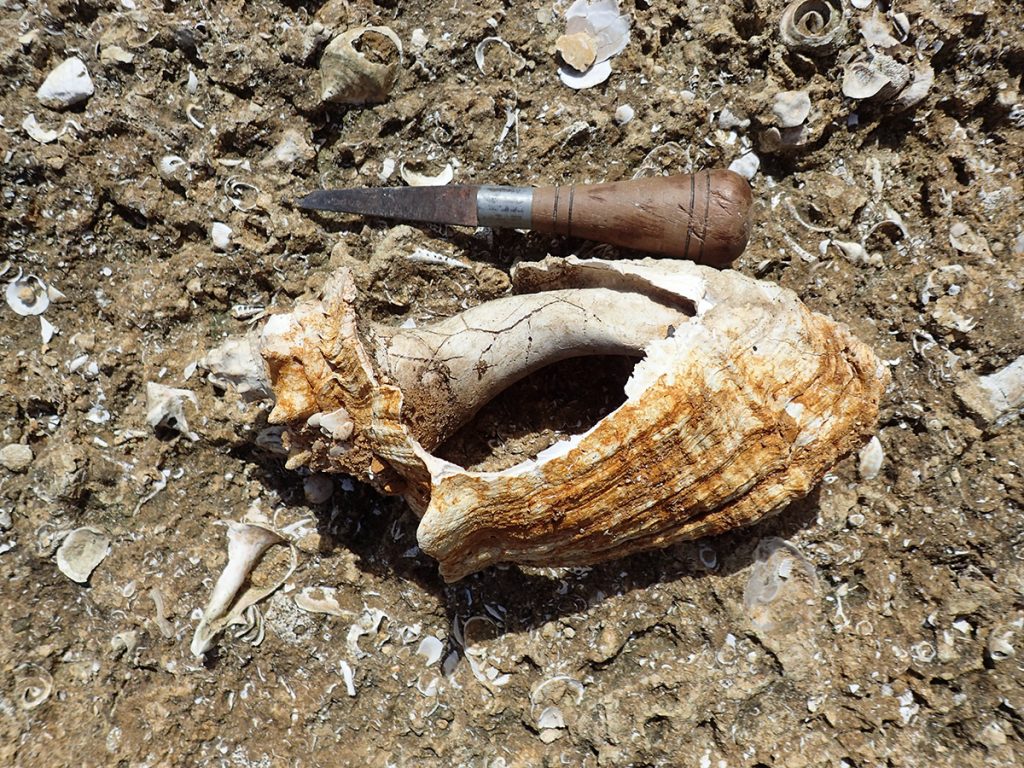
Here we have an ancient conch shell found at Alum Bluff. This is found in the Chipola Formation, which is 18 million years old. Notice how many other fossil shells are around it. There are thousands of species of mollusks found in the Chipola Formation. This kind of diversity is consistent with a tropical climate; this was likely the last time north Florida was tropical.
Harley tells us that this species of conch has been extinct for several million years, but that it likely had a common ancestor with modern conchs.
Note also how geologists use tools to provide a sense of scale in their photos.
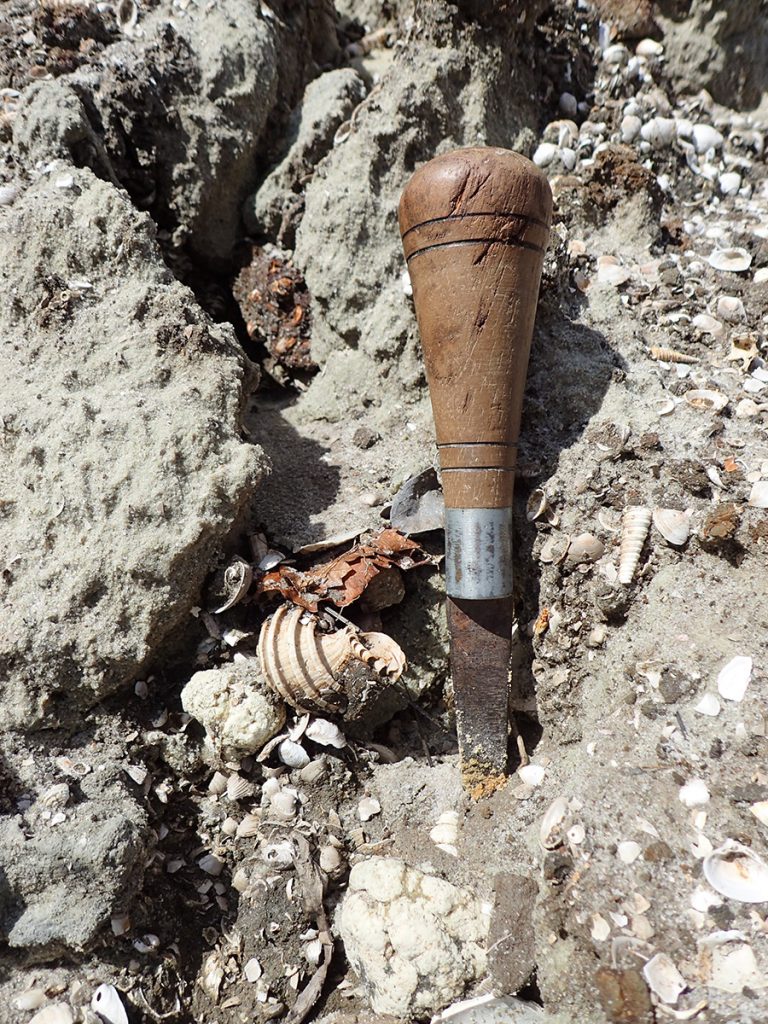
That snail fossil is an ecphora. It is what geologists call an index species. Because they only lived during a specific geologic era, you know when you find it how old the rock around it is. This is found in the Jackson Bluff Formation (3 million years), which is the dark band on the face of Alum Bluff.
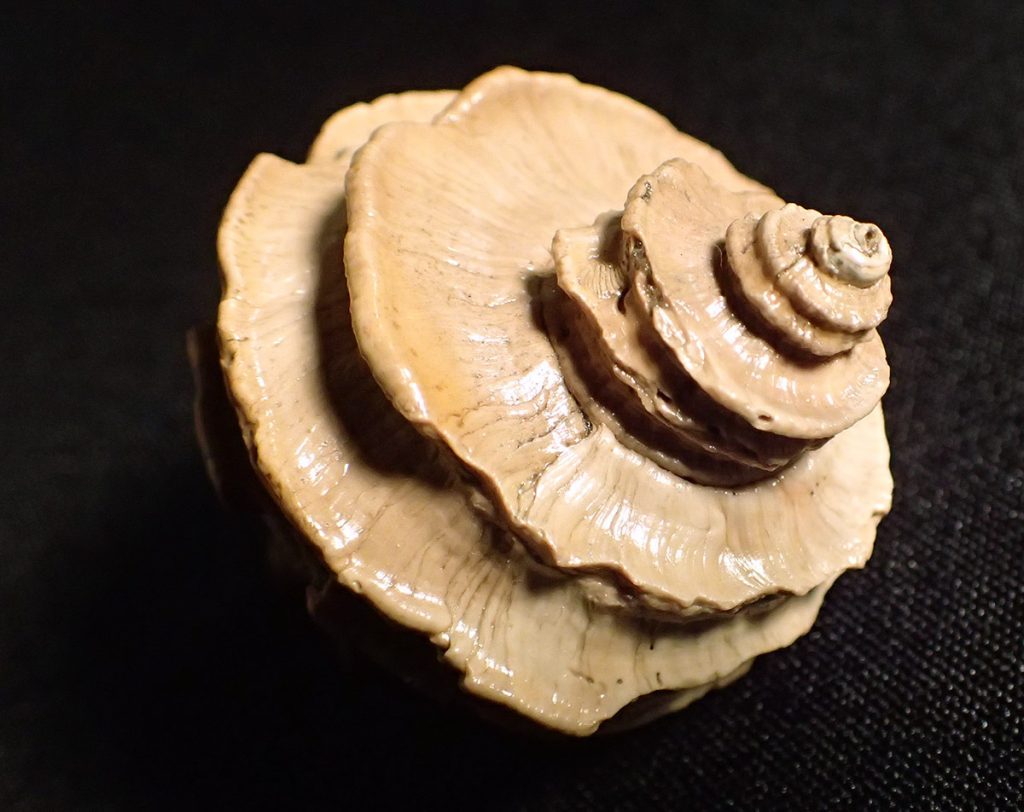
Here is a more intact ecphora. While this is a prized specimen for fossil shell collectors, it’s not uncommon in Florida.
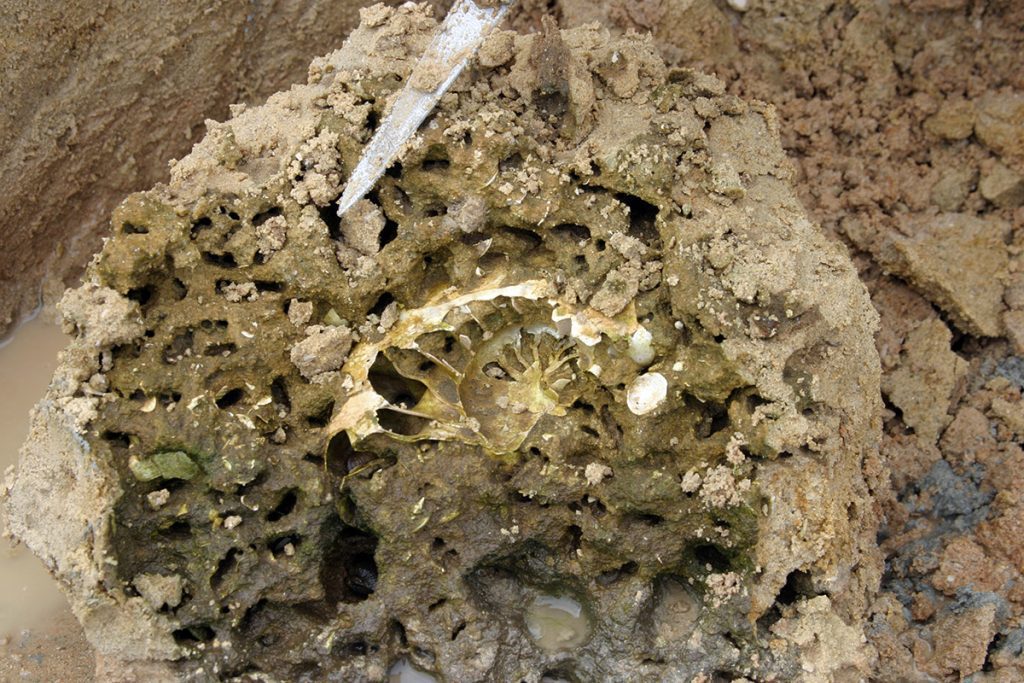
This is a fossil nautilus found in the Chipola formation (18 millions years) of Alum Bluff. Nautilus swim and have tentacles like squids, but have shells like snails.
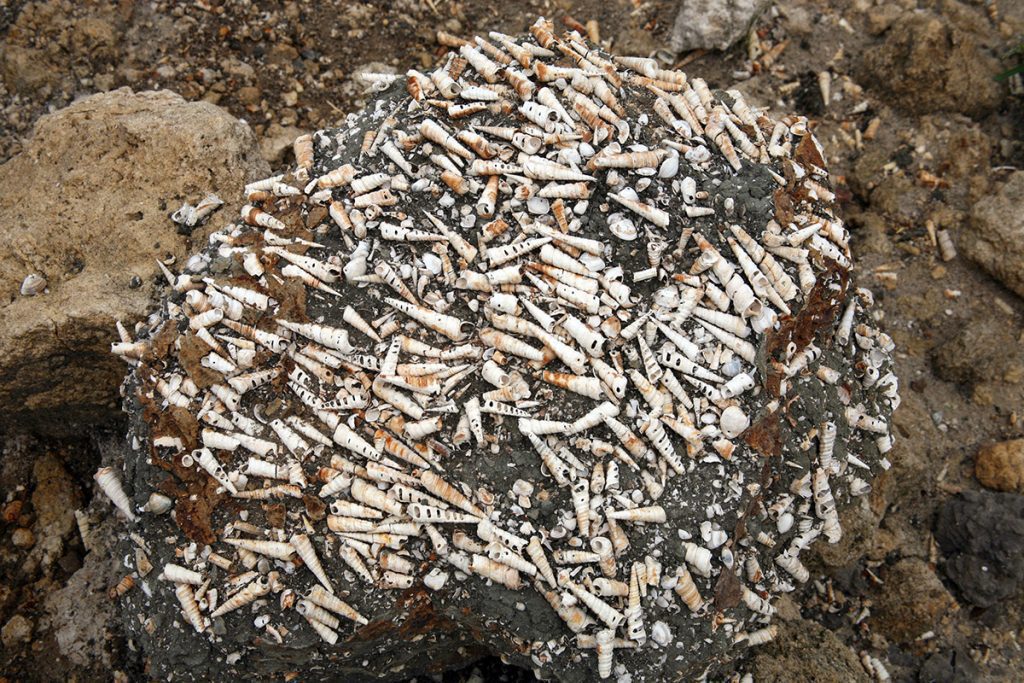
These snails are called turritella, and they were found in the Jackson Bluff Formation (3 million years old).
Fossil Plants | evidence of an ancient forest
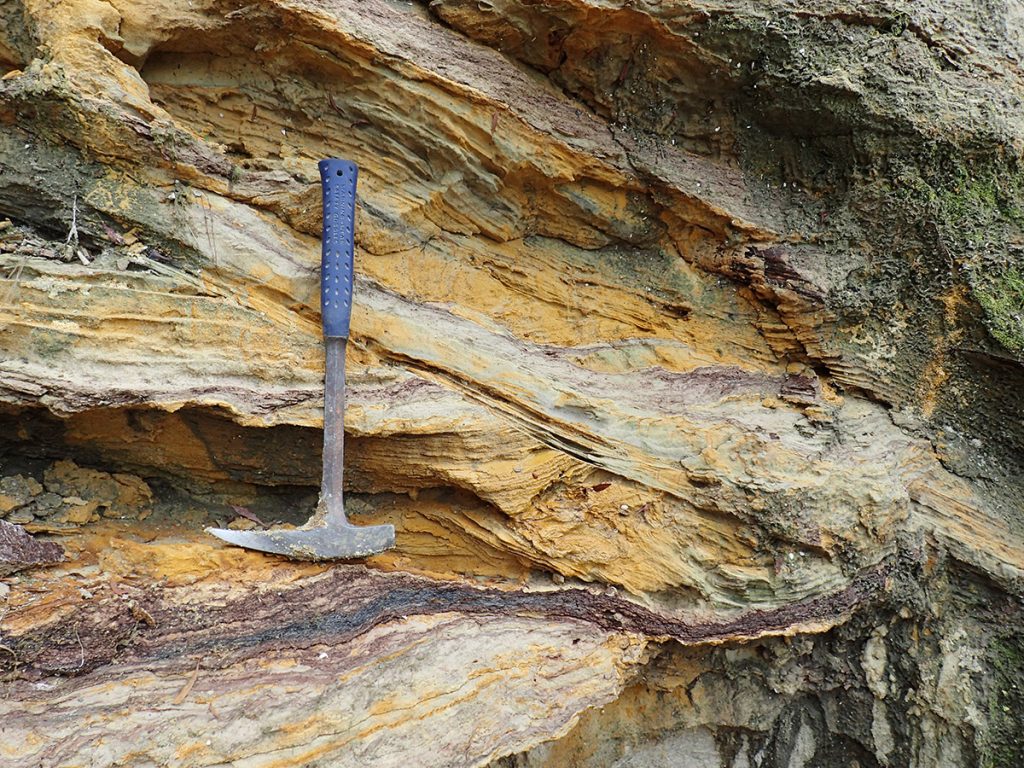
So, you’re looking at this photo and you’re asking, “Where are the plants?” That dark streak beneath the head of the hammer is organic plant matter. “If you were actually to dig into the bank and split those (layers of rock) open, what you would see are perfectly preserved leaves, and sometimes fossil nuts,” Harley told us.
This is in a formation called the Alum Bluff group. The formation is younger than the Chipola Formation (18 million years), but older than the Jackson Bluff Formation (3 million years). Those other formations are full of marine fossils, but here we have evidence of a forest. In all those millions of years, the coastline moved out and then back again.
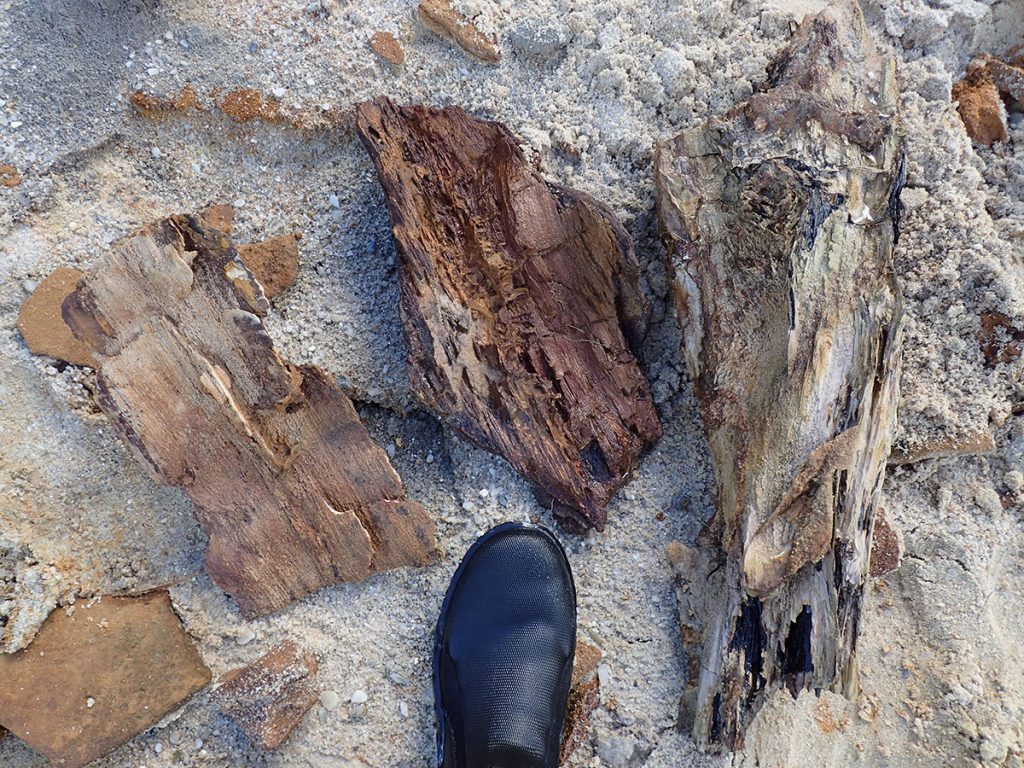
This photo was taken on a bluff alongside Bristol Landing, just south of Alum Bluff. This bluff is also a part of the Alum Bluff Group and contains fossilized wood.
“The first organisms to evolve on our planet”
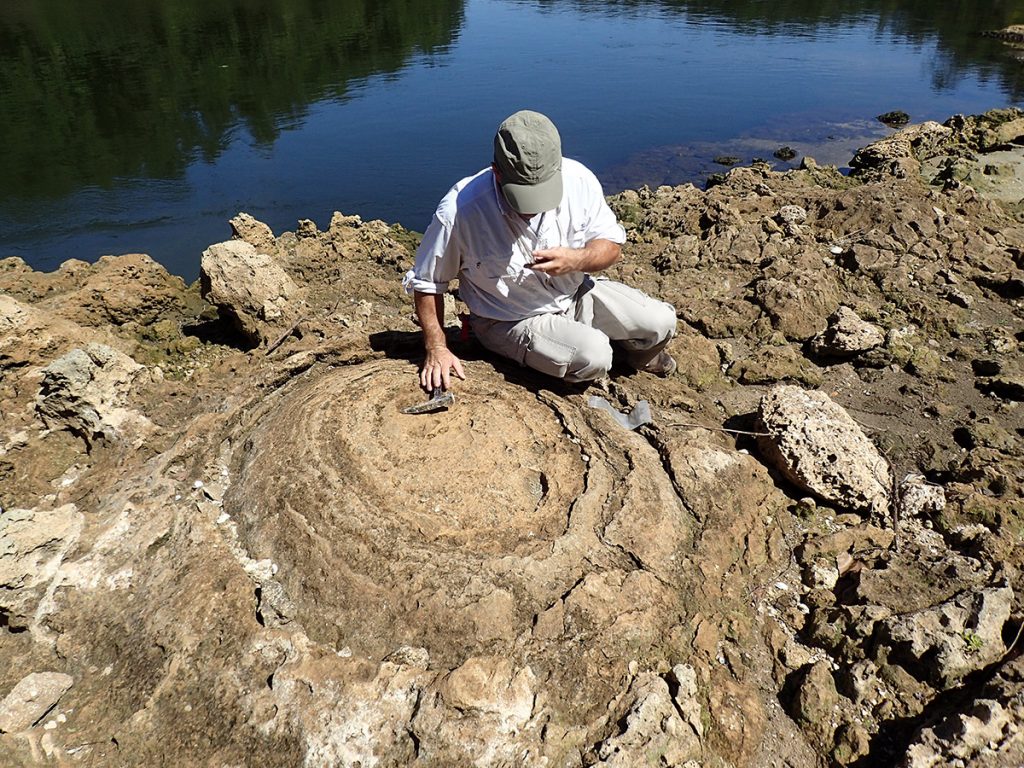
The fossils we’ve seen so far have given us a clearer picture of Alum Bluff over millions of years. This photo raises some questions.
It’s a fossil of something called a stromatolite. A stromatolite is created by blue-green algae, or cyanobacteria. The modern versions of these organisms are associated with toxic algae blooms. However, paleontologists believe that these were the first organisms to evolve on Earth. “We believe that we can find evidence for these things as far back as 3.5 billion years ago,” Harley said. “It turns out they were the dominant species and forms of life on the planet for billions of years.”
Five hundred million years ago, multicellular organisms began to take over many of the ecological niches filled by blue-green algae. Stromatolites became much less common in the fossil record. But in the photo above, we see it in the Chipola Formation, roughly 18 million years ago.
Harley was one of a group of researchers to recently publish a paper on the stromatolites at Alum Bluff. “This is the first known occurrence of fossil stromatolites in Cenozoic Florida.” He said.
There are still rare places where stromatolites can be seen today.
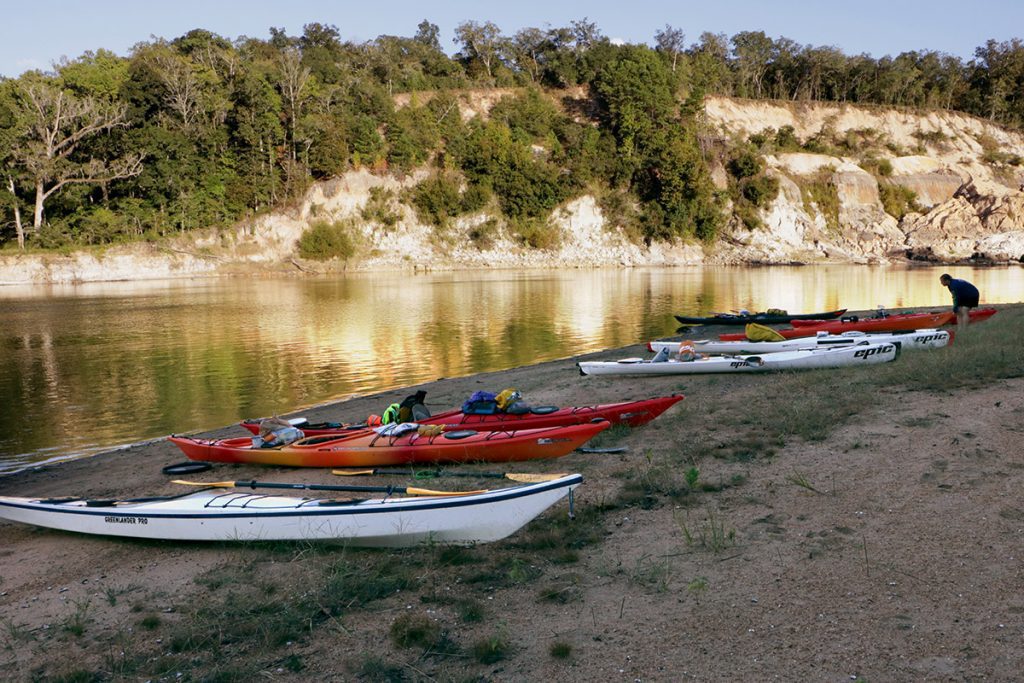
Apalachicola Bluffs and Ravines
- The eastern indigo snake: updates on releases, breeding of this endangered apex predator at the Apalachicola Bluffs and Ravines Preserve.
- Alum Bluff is the largest geological outcropping in Florida, full of fossils telling a story of Florida over 20 million years in the making. This includes fossils of the largest shark to ever swim in Earth’s oceans.
- The Apalachicola Bluffs and Ravines region is one of the top biodiversity hotspots in the United States.
- A restoration project at Torreya State Park is adding thousands of acres of habitat to the region.
- Hike a trail unlike any other in Florida – ABRP’s Garden of Eden.
An Apalachicola River billions of years in the making
If you’re observant, any walk in nature will teach you something about a given area. If you repeatedly visit a wild place, your combined experiences will give your observations greater context. You’ll see the seasons change, and what that does to plants and animals. You’ll see different critters and different animal behaviors, new plants in bloom.
If you’re a geologist like Harley Means, you may see that and a little more.
Our north Florida ecosystems took billions of years to become what we see today. On previous RiverTreks, I learned about the ecology of the Apalachicola River basin. I learned about its altered river flows, and the connection between the river, its wetlands, and the bay. Every time I come back, I bring previous experiences and knowledge with me, and it affects the way I see the river.
Next time my paddle touches the water of the Apalachicola, I’ll have dugongs and monstrous sharks in my head. If I’m really lucky, I’ll see them.*
*I meant see their fossils. I have no desire to see a fifty-foot shark while sitting in a kayak.
Over the last year, we’ve had a couple of adventures with Harley’s brother and his family, repatriating striped newts in the Apalachicola National Forest and trekking to the remotest location in Florida’s Big Bend.
This map represents a little over 20 miles of the upper Apalachicola River. The green area is Torreya State Park. Means Creek is in Torreya, but is only accessible by water. Alum Bluff is between the two big bulges north of State Road 20 on the east (right) side of the river. If you’re interested in kayaking and camping along the Apalachicola River, consult the Apalachicola Blueway Trail guide.

